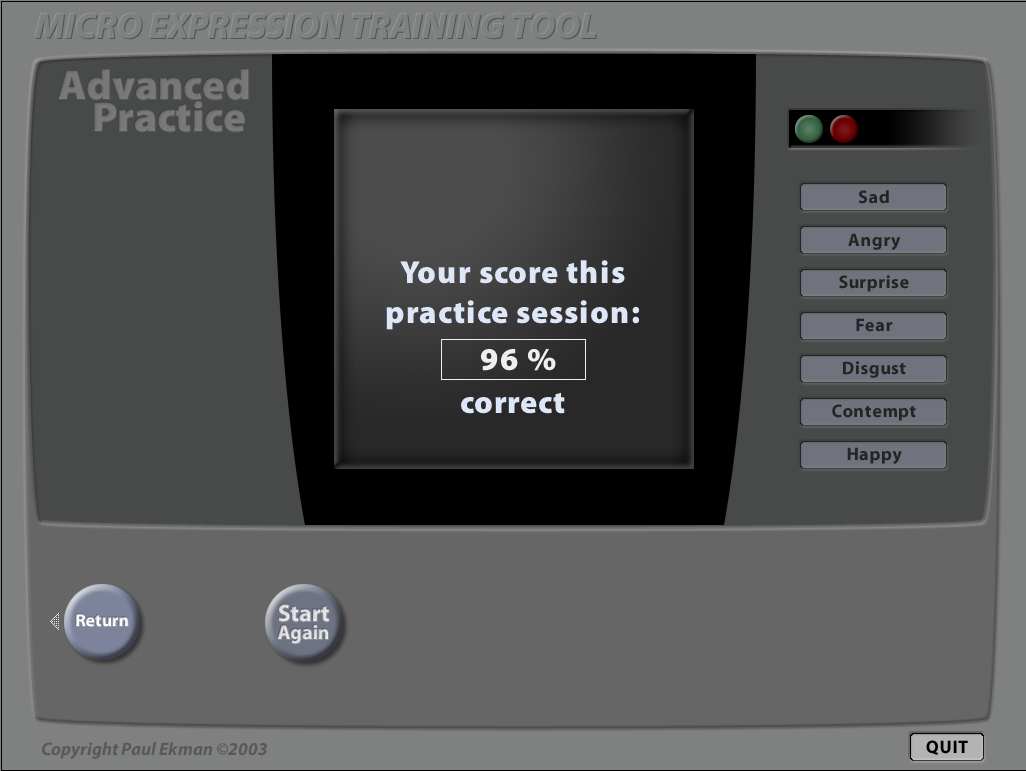
In priming tasks, the prime is often presented for a short duration and the target for a long duration, whereas the reverse is employed in synthesized micro-expression tasks. The effects of emotional context on facial expression recognition have also been observed and confirmed in numerous cognitive neuroscience research (See, for a detailed overview). It has also been observed that happy faces are recognized more accurately after positive primes than after negative ones, whereas sad expressions are recognized more accurately after negative primes. For example, anger expressions are recognized more quickly and accurately when the prime is an angry face than when it is a happy face. Some affective priming studies have found that the primes have different roles in the recognition of the different types of facial expressions. Moreover, it has also been shown that the emotional valence information appearing before the facial expression influences facial expression recognition. For example, negative facial expressions are recognized more quickly and accurately with negative context than with positive context. Previous studies have demonstrated that the current context influences recognition of facial expressions. A disgust micro-expression occurred between facial expressions (created according to METT ).


To date, it remains unknown whether the recognition of micro-expressions is influenced by the types of facial expressions appearing before and after the micro-expression, i.e., the emotional context.įigure 1. Although previous studies have employed neutral expressions before and after the emotional expression, research has indicated that micro-expressions may be embedded not only in neutral expressions but also in other facial expressions, such as happiness and sadness.

(2012), using the neutral-emotional-neutral paradigm, found that recognition accuracy rates gradually increased as presentation duration became longer but was within 200 ms. In addition, synthesized micro-expressions are also employed to investigate the characteristics and other influencing factors in micro-expression recognition research. Synthesized micro-expressions are commonly used in micro-expression recognition research as well as training materials, such as those in Ekman’s micro-expression training tool (METT), which aimed to improve people’s ability to recognize expressions. Synthesized micro-expressions refer to artificially created micro-expressions in which an emotional expression is inserted between two neutral expressions (See Figure 1). However, people usually have difficulties detecting or recognizing micro-expressions. Previous research suggests that micro-expressions are important cues for revealing true feelings and detecting deceptive behaviors. Normally, a micro-expression is embedded in the flow of expressions and occurs when people try to conceal or repress their emotions. Like facial expressions, micro-expressions also include some basic emotions, , such as anger and fear. Micro-expressions are extremely quick facial expressions that usually last for 1/25 s to 1/5 s. Therefore, our results not only provided evidence for the context effect on micro-expression recognition but also suggested that the context effect might result from both the stimulus and valence differences. Results showed that a context effect on micro-expression recognition persists even when the stimulus similarity between the context and target micro-expressions was controlled. Stimulus-difference between the context and target micro-expression was accounted for in Experiment 3. The results of Experiments 1 and 2 showed that negative context impaired the recognition of micro-expressions regardless of the duration of the target micro-expression. To address this question, the present study used a modified METT (Micro-Expression Training Tool) paradigm that required participants to recognize the target micro-expressions presented briefly between two identical emotional faces. However, it remains unclear whether the types of facial expressions appearing before and after the micro-expression, i.e., the emotional context, influence micro-expression recognition. Micro-expressions are often embedded in a flow of expressions including both neutral and other facial expressions.



 0 kommentar(er)
0 kommentar(er)
